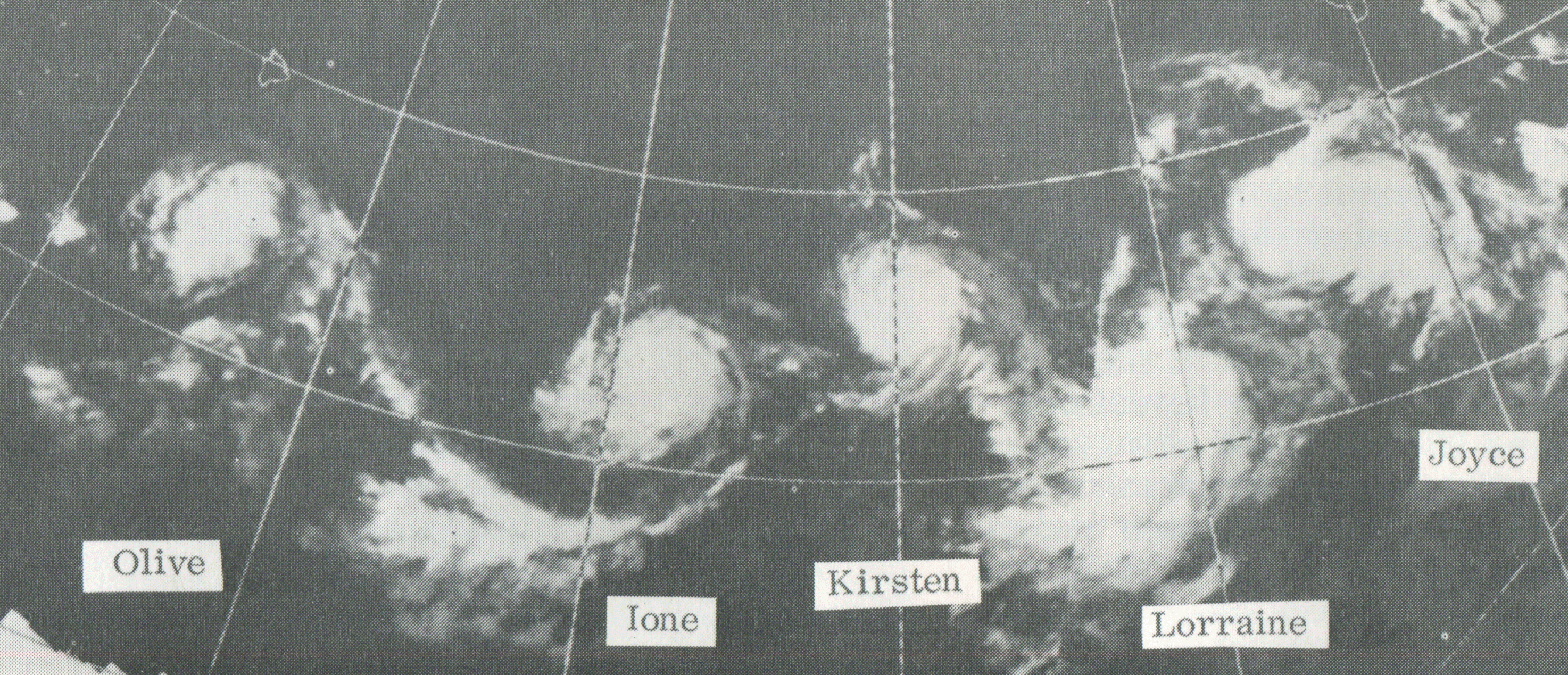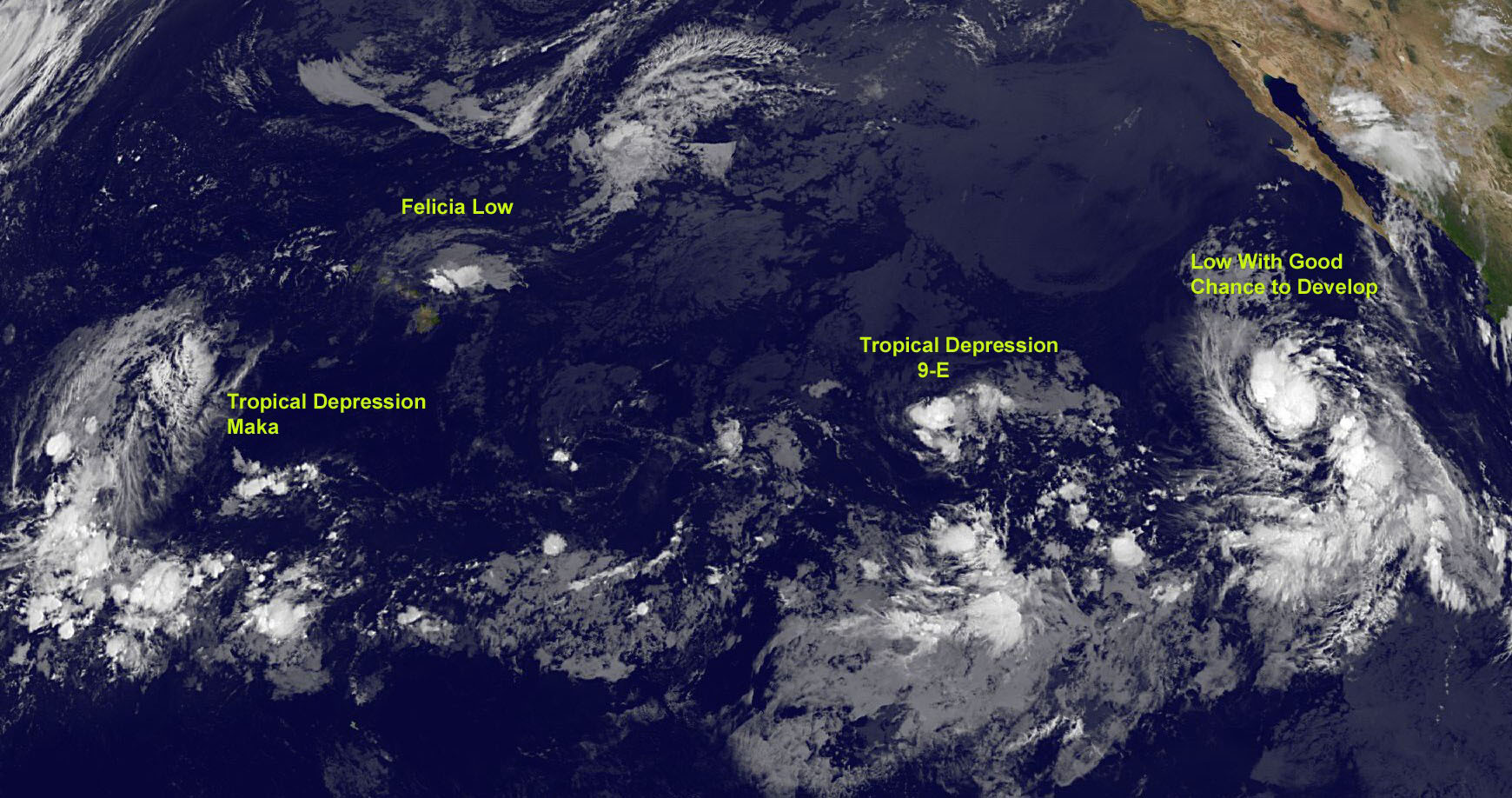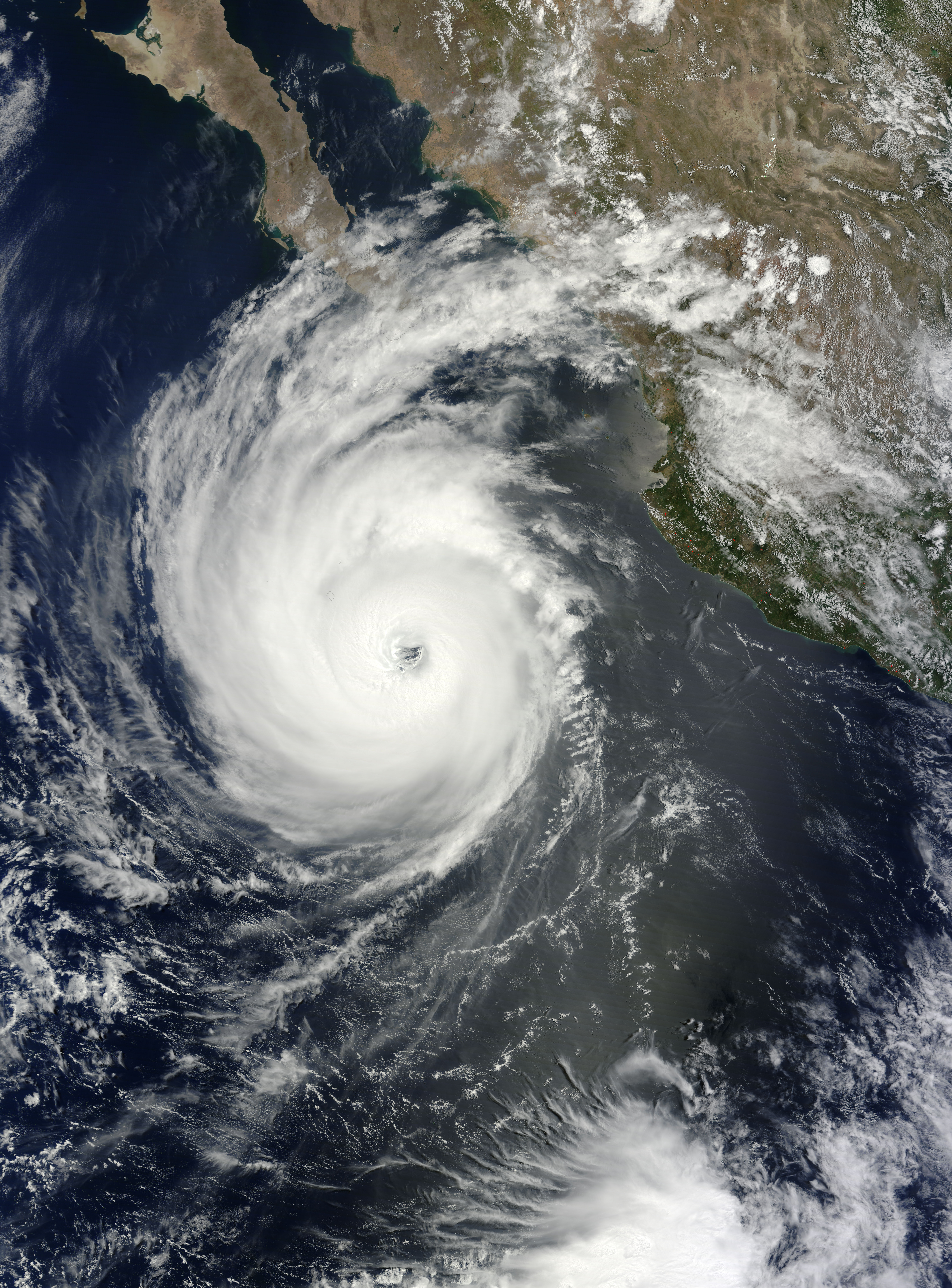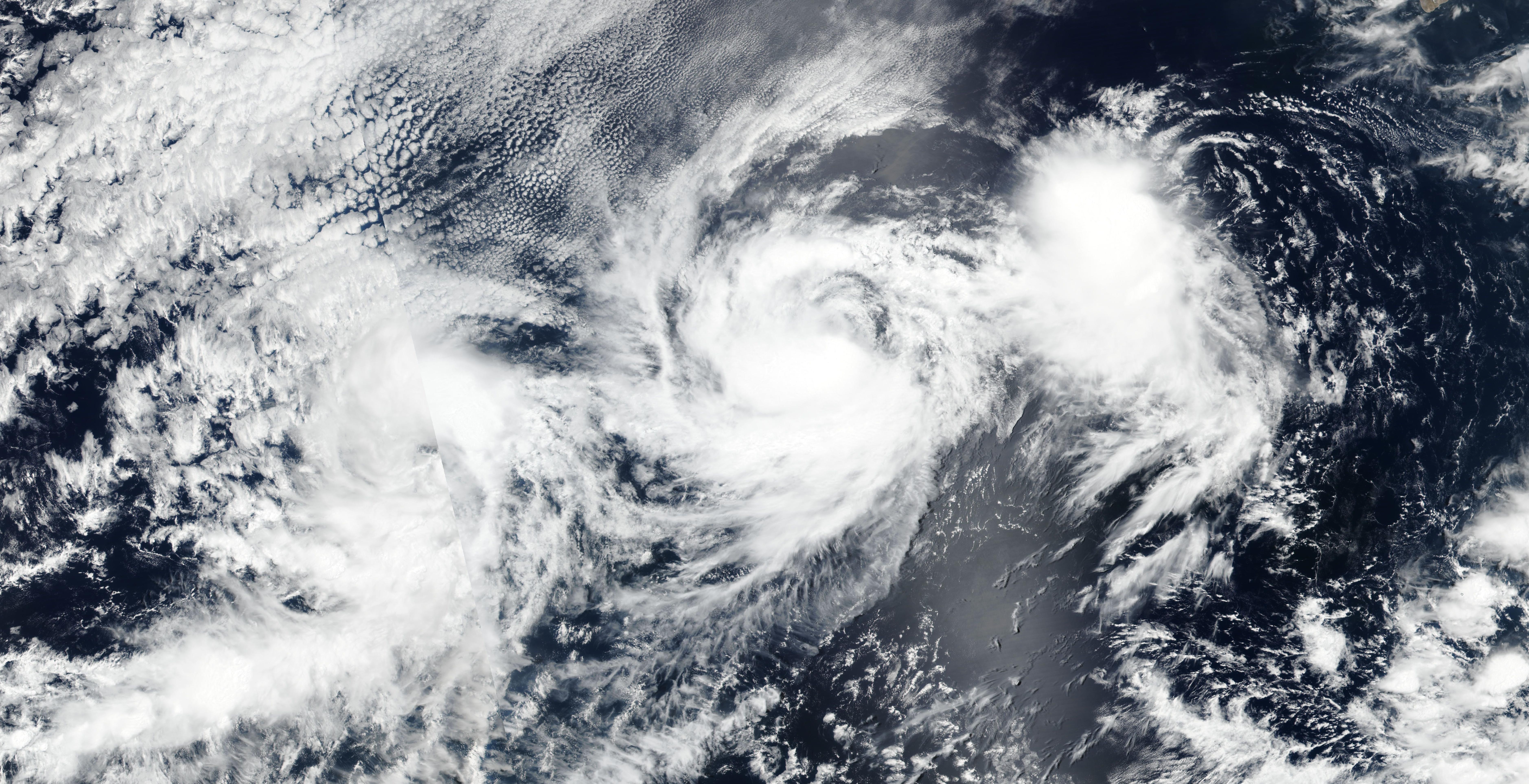|
Hurricane Blanca
The name Blanca has been used for eleven tropical cyclones in the Eastern Pacific Ocean. * Hurricane Blanca (1966), never affected land, travelled 4,300 miles during its lifetime. * Tropical Storm Blanca (1970), did not make landfall. * Tropical Storm Blanca (1974), did not make landfall. * Tropical Storm Blanca (1979), did not make landfall. * Hurricane Blanca (1985), did not affect any land. * Tropical Storm Blanca (1991), did not cause any casualties or damages. * Tropical Storm Blanca (1997), did not cause any major damage or casualties. * Tropical Storm Blanca (2003), did not have any effects on land. * Tropical Storm Blanca (2009), did not make landfall, but contributed to flooding in Mexico. * Hurricane Blanca (2015), Category 4 hurricane, made landfall in the Baja California Peninsula as a tropical storm. * Tropical Storm Blanca (2021) The 2021 Pacific hurricane season was a moderately active Pacific hurricane season, with above-average tropical activity in terms of name ... [...More Info...] [...Related Items...] OR: [Wikipedia] [Google] [Baidu] |
Tropical Cyclone
A tropical cyclone is a rapidly rotating storm system characterized by a low-pressure center, a closed low-level atmospheric circulation, strong winds, and a spiral arrangement of thunderstorms that produce heavy rain and squalls. Depending on its location and strength, a tropical cyclone is referred to by different names, including hurricane (), typhoon (), tropical storm, cyclonic storm, tropical depression, or simply cyclone. A hurricane is a strong tropical cyclone that occurs in the Atlantic Ocean or northeastern Pacific Ocean, and a typhoon occurs in the northwestern Pacific Ocean. In the Indian Ocean, South Pacific, or (rarely) South Atlantic, comparable storms are referred to simply as "tropical cyclones", and such storms in the Indian Ocean can also be called "severe cyclonic storms". "Tropical" refers to the geographical origin of these systems, which form almost exclusively over tropical seas. "Cyclone" refers to their winds moving in a circle, whirling round ... [...More Info...] [...Related Items...] OR: [Wikipedia] [Google] [Baidu] |
Hurricane Blanca (1966)
The 1966 Pacific hurricane season started on May 15, 1966, and ended November 30, 1966. The season was of little note. #Hurricane Blanca, Hurricane Blanca traveled 4,300 miles, setting a new record. During September and October of the year, Hurricane Helga and Tropical Storms Kirsten, Lorraine, and Maggie hitting Mexico. Kirsten caused 8 deaths and US$5.6 million (equivalent to $ million in ) in damages in Mexico. Systems ImageSize = width:800 height:200 PlotArea = top:10 bottom:80 right:20 left:20 Legend = columns:3 left:30 top:58 columnwidth:270 AlignBars = early DateFormat = dd/mm/yyyy Period = from:01/06/1966 till:01/11/1966 TimeAxis = orientation:horizontal ScaleMinor = grid:black unit:month increment:1 start:01/06/1966 Colors = id:canvas value:gray(0.88) id:GP value:red id:TD value:rgb(0.38,0.73,1) legend:Tropical_Depression_=_<39_mph_(0–62_km/h) id:TS value:rgb(0,0.98,0.96) legend:Tropical_Storm_=_39–73_mph_(63–117 km/h) id ... [...More Info...] [...Related Items...] OR: [Wikipedia] [Google] [Baidu] |
Tropical Storm Blanca (1970)
The 1970 Pacific hurricane season began on May 15, 1970 in the east Pacific, and on June 1, 1970 in the central Pacific. It ended on November 30, 1970. These dates conventionally delimit the period of time when tropical cyclones form in the eastern Pacific Ocean. This season had an above average number of storms. There were twenty-one tropical cyclones, of which eighteen reached tropical storm strength. Four storms became hurricanes, of which none reached major hurricane strength. In the central Pacific, one hurricane and one tropical depression formed. One of the depressions crossed the dateline to become a typhoon. __TOC__ Systems ImageSize = width:800 height:200 PlotArea = top:10 bottom:80 right:20 left:20 Legend = columns:3 left:30 top:58 columnwidth:270 AlignBars = early DateFormat = dd/mm/yyyy Period = from:01/05/1970 till:01/12/1970 TimeAxis = orientation:horizontal ScaleMinor = grid:black unit:month increment:1 start:01/05/1970 Colors = id:canvas value:gray( ... [...More Info...] [...Related Items...] OR: [Wikipedia] [Google] [Baidu] |
Tropical Storm Blanca (1974)
The 1974 Pacific hurricane season featured one of the most active periods of tropical cyclones on record with five storms existing simultaneously. The season officially started May 15 in the eastern Pacific, and June 1 in the central Pacific, and lasted until November 30. These dates conventionally delimit the period of each year when most tropical cyclones form in the northeast Pacific Ocean. With 17 named storms and 11 hurricanes, this season was slightly above average. An additional tropical storm formed in the Central Pacific as well. The year also featured a period where six systems, Ione, Olive, Kirsten, Lorraine, Joyce, and Maggie, were all active at once on August 26, a very unusual occurrence. At the time, Olive was a Central Pacific storm that had weakened to a tropical depression while the other five were of at least tropical storm intensity simultaneously and remained so until early on August 27. Five storms were also active between t ... [...More Info...] [...Related Items...] OR: [Wikipedia] [Google] [Baidu] |
Tropical Storm Blanca (1979)
The 1979 Pacific hurricane season was an inactive season, featuring 10 named storms, 6 hurricanes, and 4 major hurricanes. It featured zero tropical cyclones in the Central Pacific, the most recent occurrence on record as of 2021. An average year sees four to five tropical cyclones in that basin. Seasonal activity in 1979 remained within the confines of a traditional hurricane season, which begins on May 15 and ends on November 30 in the East Pacific basin. Those dates conventionally delimit the period during each year when most tropical cyclones occur. The season's first system, Andres, developed on May 31, while the year's final cyclone, Jimena, dissipated on November 18. In early June, Andres moved onshore Mexico as a minimal hurricane, while in late October, Ignacio struck the coastline as a tropical depression. Impacts from those storms were minimal, as were the effects of the preponderance of systems during the season. No casualties or damage were reporte ... [...More Info...] [...Related Items...] OR: [Wikipedia] [Google] [Baidu] |
Hurricane Blanca (1985)
The 1985 Pacific hurricane season is the third-most active Pacific hurricane season on record. It officially started on May 15, 1985, in the eastern Pacific, and on June 1, 1985, in the central Pacific, and lasted until November 30, 1985. These dates conventionally delimit the period of each year when most tropical cyclones form in the northeastern Pacific Ocean. At the time, the 1985 season was the most active on record in the eastern north Pacific, with 28 tropical cyclones forming. Of those, 24 were named, 13 reached hurricane intensity, and 8 became major hurricanes by attaining Category 3 status or higher on the Saffir–Simpson scale. At that time, the 24 named storms was a record; however, this record was broken seven years later in 1992, and was therefore recognized as the second busiest season within the basin, until it was surpassed exactly thirty years later by the 2015 season. Despite the activity, only one system made landfall in 1985. Hurricane Waldo caused mod ... [...More Info...] [...Related Items...] OR: [Wikipedia] [Google] [Baidu] |
Tropical Storm Blanca (1991)
The 1991 Pacific hurricane season was a near-average Pacific hurricane season. The worst storm this year was Tropical Storm Ignacio, which killed 23 people in Mexico and injured 40 others. Elsewhere, Hurricane Fefa caused flooding in Hawaii. Hurricane Kevin was the strongest system of the season and became the then longest-lasting hurricane in the eastern north Pacific basin at the time, and Hurricane Nora was the strongest November storm to that point. The season officially started on May 15, 1991, in the eastern Pacific, and on June 1, 1991, in the central Pacific. It lasted until November 30, 1991, in both basins. These dates conventionally delimit the period of each year when most tropical cyclones form in the northeastern Pacific Ocean. Seasonal summary ImageSize = width:800 height:215 PlotArea = top:10 bottom:80 right:20 left:20 Legend = columns:3 left:30 top:58 columnwidth:270 AlignBars = early DateFormat = dd/mm/yyyy Period = from:01/05/1991 till:01/12/1991 T ... [...More Info...] [...Related Items...] OR: [Wikipedia] [Google] [Baidu] |
Tropical Storm Blanca (1997)
The 1997 Pacific hurricane season was a very active hurricane season. With hundreds of deaths and hundreds of millions of dollars in damage, this season was one of the costliest and deadliest Pacific hurricane seasons. This was due to the exceptionally strong 1997–98 El Niño event. The season officially started on May 15, in the eastern Pacific, and on June 1, in the central Pacific, and lasted until November 30. These dates conventionally delimit the period of each year when almost all tropical cyclones form in the northeastern Pacific Ocean. Several storms impacted land. The first was Tropical Storm Andres which killed four people and left another two missing. In August, Tropical Storm Ignacio took an unusual path, and its Extratropical cyclone, extratropical remnants caused minor damage in the Pacific Northwest and California. Hurricane Linda (1997), Linda became the most intense east Pacific hurricane in recorded history, a record it maintained until it was surpassed by H ... [...More Info...] [...Related Items...] OR: [Wikipedia] [Google] [Baidu] |
Tropical Storm Blanca (2003)
The 2003 Pacific hurricane season was the first season to feature no major hurricanes – storms of Category 3 intensity or higher on the Saffir–Simpson scale, Saffir–Simpson hurricane wind scale (SSHWS) – since 1977 Pacific hurricane season, 1977. The dates conventionally delimiting the period when most tropical cyclones form in the Pacific Ocean are May 15 in the Eastern Pacific Ocean and June 1 in the Central Pacific, with both seasons ending on November 30. The 2003 season featured 16 tropical storms between May 19 and October 26; 7 of these became hurricanes, which was then considered an average season. Damage across the basin reached US$129 million, and 23 people were killed by the storms. Despite the overall lack of activity, the season produced an unusually large number of tropical cyclones that affected Mexico, with eight tropical cyclones making landfall on either side of Mexico, which was the second highest on record. Tropi ... [...More Info...] [...Related Items...] OR: [Wikipedia] [Google] [Baidu] |
Tropical Storm Blanca (2009)
The 2009 Pacific hurricane season was the most active Pacific hurricane season since 1994. The season officially started on May 15 in the East Pacific Ocean, and on June 1 in the Central Pacific; they both ended on November 30. These dates conventionally delimit the period of each year when most tropical cyclones form in the Pacific basin. However, the formation of tropical cyclones is possible at any time of the year. For the first time in ten years, no tropical depressions formed during the month of May. This inactivity continued into the early part of June and was the least active since 1994. The first named storm of the season did not develop until June 21, marking the latest start to a Pacific hurricane season in 40 years. However, according to the NHC's tropical weather summary, August 2009, with seven named storms in their region, was one of the most active Augusts on record for the basin. This level of activity had rarely occurred, if at all, in the past 41 years, since 1 ... [...More Info...] [...Related Items...] OR: [Wikipedia] [Google] [Baidu] |
Hurricane Blanca (2015)
Hurricane Blanca in 2015 was the earliest recorded tropical cyclone to make landfall on the Baja California Peninsula. Forming as a tropical depression on May 31, Blanca initially struggled to organize due to strong wind shear. However, once this abated, the system took advantage of high sea surface temperatures and ample moisture. After becoming a tropical storm on June 1, Blanca rapidly intensified on June 2–3, becoming a powerful Category 4 hurricane on the Saffir–Simpson hurricane wind scale; maximum sustained winds reached 145 mph (230 km/h) at this time. The hurricane's slow motion resulted in tremendous upwelling of cooler water, resulting in a period of weakening. Blanca gradually recovered from this and briefly regained Category 4 status on June 6 as it moved generally northwest toward the Baja California peninsula. Cooler waters and increased shear again prompted weakening on June 7 and the system struck Baja California ... [...More Info...] [...Related Items...] OR: [Wikipedia] [Google] [Baidu] |
Tropical Storm Blanca (2021)
The 2021 Pacific hurricane season was a moderately active Pacific hurricane season, with above-average tropical activity in terms of named storms; but featured below-average activity in terms of major hurricanes and a near-normal accumulated cyclone energy (ACE). Five of the season's nineteen named storms made landfall in Mexico, the most since 2018. The season officially began on May 15 in the Eastern Pacific, and on June 1 in the Central Pacific; both ending on November 30. These dates historically describe the period each year when most tropical cyclones form in the Pacific basin and are adopted by convention. However, the formation of tropical cyclones is possible at any time of the year, as illustrated by the formation of Tropical Storm Andres on May 9, which became the earliest forming tropical storm in the northeastern Pacific proper (east of 140°W longitude) on record. In June, Tropical Storm Dolores made landfall near the border of the Mexican states of Col ... [...More Info...] [...Related Items...] OR: [Wikipedia] [Google] [Baidu] |




